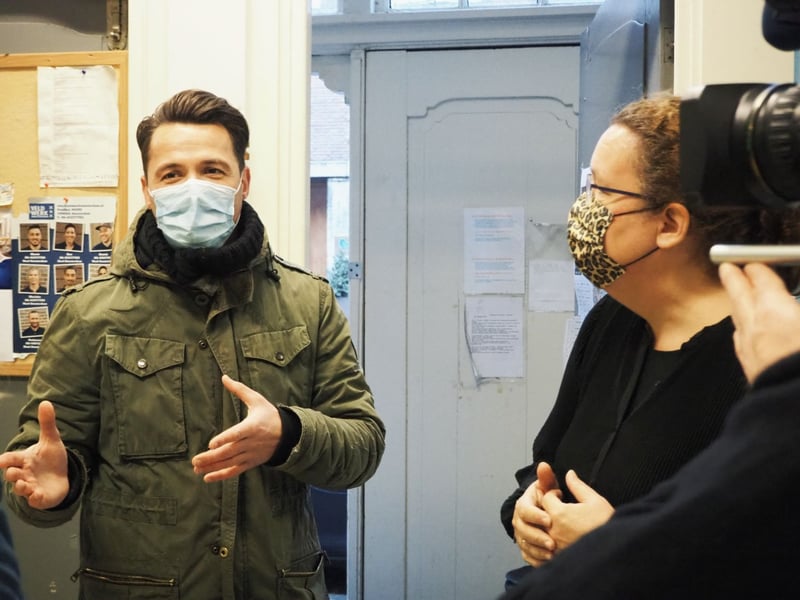Simone Schoemaker works at "Tot Heil des Volks", or THDV for short. She's the head of communications there. The tagline of this Christian group is "Who do you see?" What comes to mind when you see a prostitute, addict, or homeless person? Can you ditch your biases and connect with these vulnerable folks? In the Jordaan neighborhood, we handed out 5 Sheltersuits. A German ARD camera crew caught it all on tape!
"When I'm cozy and warm tonight, I'll be thinking of you!" That's what Ruud, a homeless man, said after getting his Sheltersuit. He's been homeless in Amsterdam since 1984. He used to rely on a good drink to keep him warm before bed. Now, he's got this comfy Sheltersuit that keeps him and his prized possessions safe from the cold. Another local, just like Ruud, also got a Sheltersuit. They shared their stories with the ARD crew. THDV is holding onto the remaining 3 suits because they expect more folks will be coming by for help this winter.

Let's circle back to Simone. She used to be a social worker for the "Scharlaken Koord", which is part of THDV. She'd reach out to prostitutes in Amsterdam's red-light districts, brothels, and nightclubs. "Force and violence are pretty common in the sex industry. I'd lend a listening ear to these women. For those wanting out, we've got an exit program." They can then get work experience at THDV's thrift shop, Second Step. "Sadly, there's still a lot of judgment around these women, even after they've left the industry. The shop gives them a fresh start."
Grumpy faces, shabby clothes
Four years ago, Simone switched roles within THDV. She transitioned to head of communications. For the first time, she started working with other target groups of the organization: addicts, kids living in poverty, and the homeless. For the latter, they've got two shelters. "In the Wallen area, we've got this cozy living room. A place to chat or play board games. Plus, we serve warm meals there." Simone added that their Jordaan shelter is bigger. "We've got showers there and we hand out clean clothes."
When Simone first walked into the shelter, she was met with unkempt faces and grumpy looks. How was she gonna chat with these guys in their worn-out gear? A coworker suggested she just take a seat at the table. "It was a bit out of my comfort zone, but soon enough, we were all chatting." Before she knew it, Simone felt right at home. She realized she wasn't that different from them.
Invisible among the crowd
Once you break the ice, trust builds. The men start opening up. One day, a homeless guy was helping out, pouring coffee. "Hey, Simone," he greeted her as she walked in. Simone looked at him, not recognizing him. Had they met before? After introducing himself as Piet, they had a conversation about names.
"People just walk past the homeless like they're invisible. It's heartbreaking."
Piet said folks just walk by him like he doesn't exist. That cuts deep. "From that point, remembering names became a big deal for me. People want to be seen for who they are, not what they are." Personal touch is a big thing at THDV. "Homeless folks aren't just numbers we serve food to. It's all about connecting."
Fitting in is tough
According to Simone, the Dutch "system" works fine if you've got your stuff together. The real mess starts when you fall through the cracks. To apply for a new ID, you need to be registered with the municipality. For welfare, you need a home address. If you apply for a mail address, you're suddenly on the radar of debt collectors and law enforcement.
"If you've fallen out of the system, getting back in is a struggle."
Plus, official letters are usually filled with confusing jargon. "What I'm getting at is, a lot of homeless folks' lives are already a mess. They don't have all their documents neatly filed or saved on a computer. Once you're out, it's hard to get back in."
Simone recalls a young woman who lost her ID. All the bureaucracy was just too much for her. She came from a rough background, was dealing with trauma, and was homeless. The streets are pretty dangerous for someone like her. "Don't worry about me, I'll be fine," she told Simone. She came to the shelter a couple more times. No one knows what happened to her after that. "It's hard not knowing, but you gotta let go. Otherwise, this job's not for you."
Make it personal and relatable
As a communications specialist, Simone sees herself as a storyteller. Before COVID-19, she'd visit churches, schools, and other groups to share THDV's work. "Personal stories touch people and help them relate to the issues."
"Anyone who says there's no poverty in the Netherlands is living in a bubble."
She also gives tours around Amsterdam's streets and alleys. "I tell stories about the lives of the people we work with during these walks." Some rich dude in a group of business folks once claimed there's no poverty in the Netherlands.
"That one's mine," Simone thought after hearing that. "Maybe in your bubble there's no poverty. If I can change how someone like him sees the world, I've done my job. Unfortunately, poverty and homelessness are very real in our prosperous country."




